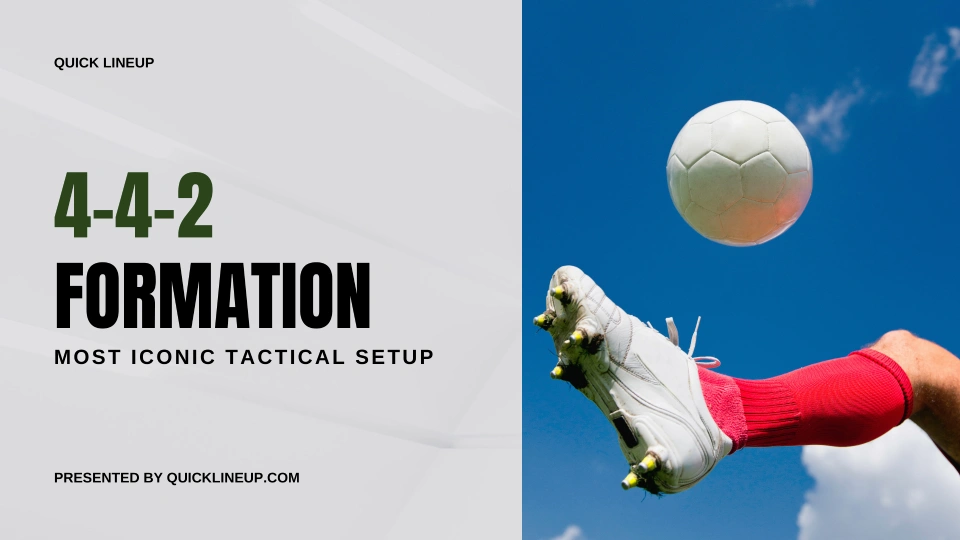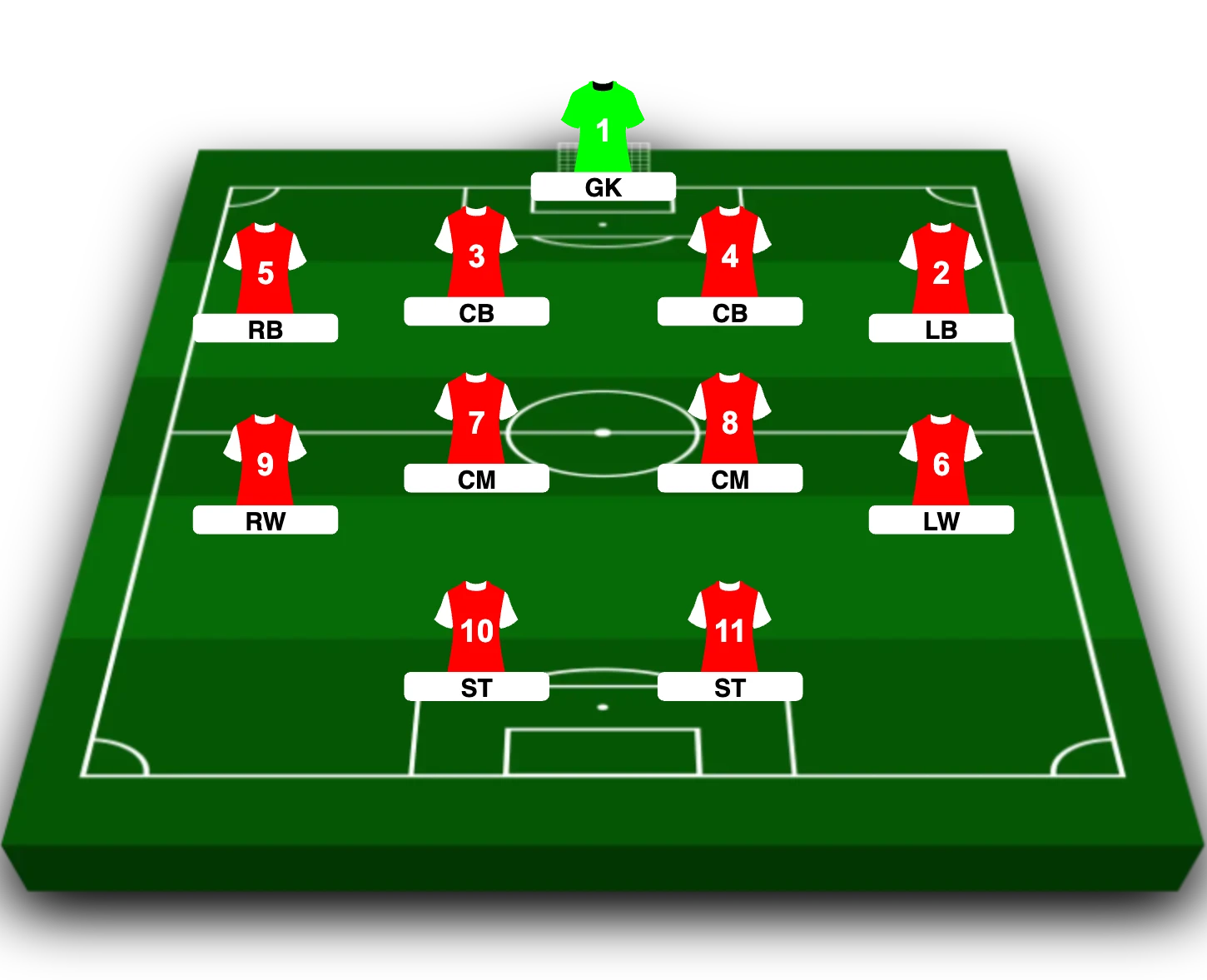The Classical Football Formation: 4-4-2

The 4-4-2 formation, consisting of four defenders, four midfielders, and two forwards, has been one of the most popular tactics in football for years. It’s simple, well-balanced, and works both defensively and offensively. With two wide players who support both the attack by providing width and crossing opportunities, and the defense by tracking back to cover opposing wingers, teams can stay compact while still creating chances going forward.
Even though modern football has shifted towards three-man midfields, which offer better control by allowing more players in the center of the pitch, the 4-4-2 is still a great option, especially for teams that like to play on the counter. It’s easy to understand, effective, and works well at all levels, from professional to amateur teams.
Player Positions in the 4-4-2 Formation

Defenders (Back Four)
- Left-Back (LB): Provides defensive coverage on the left side while supporting attacks with overlapping runs
- Center-Backs (CB): Two central defenders who organize the defense, mark strikers, and initiate build-up play
- Right-Back (RB): Mirrors the left-back's role on the right side of defense
Midfielders (Middle Four)
- Left Midfielder/Winger (LM): Operates on the left flank, providing width in attack and defensive support
- Central Midfielders (CM): Two players who control the middle, with one typically more defensive and the other more attack-minded
- Right Midfielder/Winger (RM): Operates on the right flank, similar to the left midfielder's role
Forwards (Front Two)
- Strikers (ST): Two forwards who lead the attack, typically combining a target man with a more mobile striker
Advantages of the 4-4-2 Formation
-
Balanced Structure and Tactical Flexibility: The 4-4-2 formation creates strategic triangles across the pitch, facilitating smooth transitions between attack and defense. Teams can easily shift between defensive and offensive phases due to the formation's balanced player distribution, which maintains optimal spacing.
-
Superior Pressing Capabilities: With two forwards leading the press and four midfielders providing support, this formation excels at disrupting opponent build-up play by applying pressure high up the pitch and cutting off passing lanes. The wide midfielders can effectively press in tandem with fullbacks, creating numerical advantages in crucial defensive areas.
-
Straightforward Defensive Organization: Two compact lines of four players provide excellent defensive coverage and make the formation easy to coach. This structured approach helps teams maintain their shape and minimizes spaces that opponents can exploit between defensive lines.
-
Effective Counter-Attacking System: The formation naturally supports quick transitions from defense to attack; wide players and striker partnerships create multiple attacking options. This makes 4-4-2 particularly effective for teams focusing on counter-attacking football.
-
Strong Strike Partnerships: The two-striker system allows for various combinations - target man with poacher, false nine with shadow striker, or dual mobile forwards - providing tactical versatility in attack.
Weaknesses of the 4-4-2 Formation
-
Midfield Control Challenges: Against three-man midfields, the formation often fails to maintain possession and control the game's tempo. The two central midfielders often become overwhelmed by possession-dominating teams.
-
Creative Limitations: Without a dedicated attacking midfielder, teams may find it difficult to break down organized defenses as they lack a central playmaker to create opportunities and link the midfield with the attack. The lack of a number 10 position can lead to predictable attacking patterns.
-
High Physical Demands: Players must maintain exceptional fitness levels as the system requires significant running, particularly from the wide midfielders and full-backs, who need to cover both defensive and attacking duties. Midfielders especially need to cover large areas of the pitch throughout the match.
-
Modern Tactical Vulnerabilities: Teams using fluid positioning and high pressing can exploit spaces between the midfield and defensive lines, taking advantage of the gaps left by the two central midfielders and the back four. The formation can also struggle against sophisticated build-up play and teams that effectively use false nines.
Legendary Implementations: Tactical Case Studies
1. Sir Alex Ferguson's Asymmetric 4-4-2 at Manchester United
1998-1999 Treble-Winning Tactics:
- Right-Sided Overload: Beckham + Neville partnership.
- Scholes' False Winger Role: Goal contributions from midfield.
- Defensive Balance: Stam's aggression + Irwin's positioning.
Key Metrics:
- Effective Yorke-Cole striker partnership.
- Clean sheets through defensive organization.
- Right-flank focused attacks.
"Attack wins you games, defence wins you titles." - Sir Alex Ferguson
2. Diego Simeone's Reactive 4-4-2: Atletico Madrid's UCL Success
2013-2014 La Liga Triumph:
- 2.37 Points / Match
- Koke + Gabi: 21 assists
- Costa + Villa: 40 goals
European Impact:
- 2.03 Goals / Match
- 0.68 Goals Conceded / Match
- Champions League Finalist
Source: Footystats.org
3. Leicester City 2016: Counter-Attacking Masterclass
Title-Winning Statistics:
| Metric | Value | League Rank |
|---|---|---|
| Matches | 38 | - |
| Goals | 68 | 3rd |
| Goals/Match | 1.79 | 3rd |
| Assists | 45 | 5th |
| Expected Goals (xG) | 66.28 | 1st |
| Expected Assists (xA) | 41.38 | 5th |
| Possession % | 42.6 | 18th |
| Penalties | 10 | 1st |
| Free Kicks | 0 | 14th |
| Shots | 522 | 7th |
| Shots on Target | 179 | 6th |
| Touches | 21,938 | 18th |
| Touches in Box | 0 | 8th |
Source: Statmuse.com
Conclusion
The 4-4-2 formation is a classic tactical setup that has stood the test of time. Its balanced structure and tactical versatility make it a great option for both professional and amateur teams.
Related formations
You can build your own lineup with Quick Lineup and try it out on the pitch.
